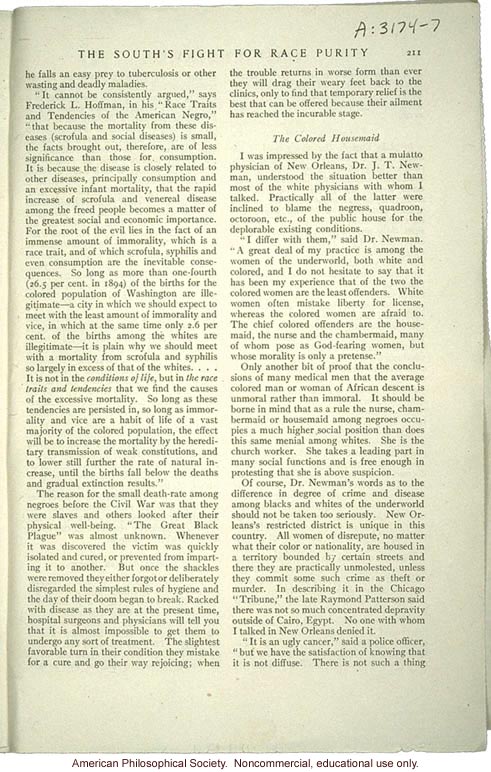[marginalia]A:3174-7[end marginalia]
The South's Fight for Race Purity 211
he falls an easy prey to tuberculosis or other wasting and deadly maladies.
"It cannot be consistently argued," says Frederick L. Hoffman, in his "Race Traits and Tendencies of the American Negro," "that because the mortality from these diseases (scrofula and social diseases) is small, the facts brought out, therefore, are of less significance that those for consumption. It is because the disease is closely related to other diseases, principally consumption and an excessive infant mortality, that the rapid increase of scrofula and venereal disease among the freed people becomes a matter of the greatest social and economic importance. For the root of the evil lies in the fact of an immense amount of immorality, which is a race trait, and of which scrofula, syphilis and even consumption are the inevitable consequences. So long as more than one-fourth (26.5 per cent. in 1894) of the births for the colored population of Washington are illegitimate - a city in which we should expect to meet with the least amount of immorality and vice, in which at the same time only 2.6 per cent. of the births among the whites are illegitimate - it is plain why we should meet with a mortality from scrofula and syphilis so largely in excess of that of the whites...It is not in the conditions of life, but in the race traits and tendencies that we find the causes of the excessive mortality. So long as these tendencies are persisted in, so long as immorality and vice are a habit of life of a vast majority of the colored population, the effect will be to increase the mortality by the hereditary transmission of weak constitutions, and to lower still further the rate of natural increase, until the births fall below the deaths and gradual extinction results."
The reason for the small death-rate among negroes before the Civil War was that they were slaves and others looked after their physical well-being. "The Great Black Plague" was almost unknown. Whenever it was discovered the victim was quickly isolated and cured, or prevented from imparting it to another. But once the shackles were removed they either forgot or deliberately disregarded the simplest rules of hygiene and the day of their doom began to break. Racked with disease as they are at the present time, hospital surgeons and physicians will tell you that it is almost impossible to get them to undergo any sort of treatment. The slightest favorable turn in their condition they mistake for a cure and go their way rejoicing; when the trouble returns in worse form than ever they will drag their weary feet back to the clinics, only to find that temporary relief is the best that can be offered because their ailment has reached the incurable stage.
The Colored Housemaid
I was impressed by the fact that a mulatto physician of New Orleans, Dr. J. T. Newman, understood the situation better than most of the white physicians with whom I talked. Practically all of the latter were inclined to blame the negress, quadroon, octoroon, etc., of the public house for the deplorable existing conditions.
"I differ with them," said Dr. Newman. "A great deal of my practice is among the women of the underworld, both of white and colored, and I do not hesitate to say that it has been my experience that of the two the colored women are the least offender. White women often mistake liberty for license, whereas the colored women are afraid to. The chief colored offenders are the housemaid, the nurse and the chambermaid, many of whom pose as God-fearing women, but whose morality is only a pretense."
Only another bit of proof that the conclusions of many medical men that the average colored man or woman of African descent is unmoral rather than immoral. It should be borne in mind that as a rule the nurse, chambermaid or housemaid among the negroes occupies a much higher social position than does this same menial among whites. She is the church worker. She takes a leading part in many social functions and is free enough in protesting that she is above suspicion.
Of course, Dr. Newman's words as to the difference in degree of crime and disease among blacks and whites of the underworld should not be taken too seriously. New Orleans's restricted district is unique in this country. All women of disrepute, no matter what their color or nationality, are housed in a territory bounded by certain streets and there they are practically unmolested, unless they commit some such crime as theft or murder. In describing it in the Chicago "Tribune," the late Raymond Patterson said there was not so much concentrated depravity outside of Cairo, Egypt. No one with whom I talked in New Orleans denied it.
"It was an ugly cancer," said a police officer, "but we have the satisfaction of knowing that it is not diffuse. There is not such a thing


